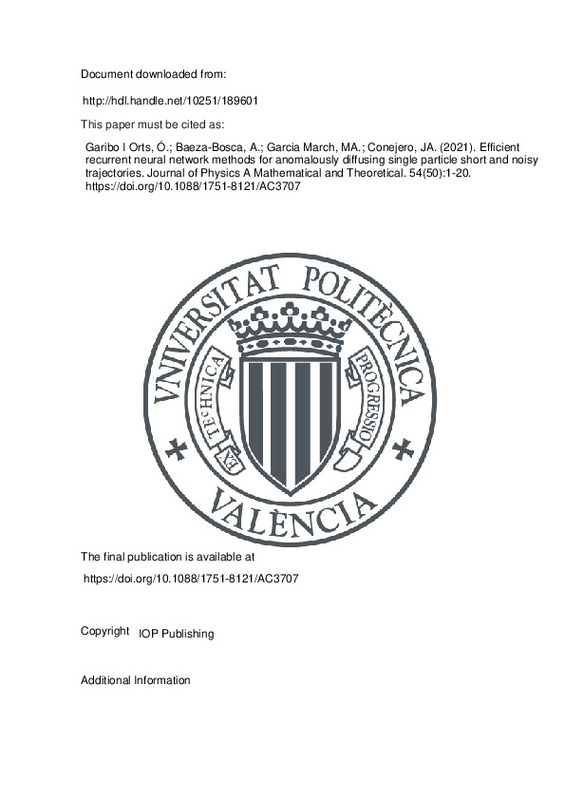JavaScript is disabled for your browser. Some features of this site may not work without it.
Buscar en RiuNet
Listar
Mi cuenta
Estadísticas
Ayuda RiuNet
Admin. UPV
Efficient recurrent neural network methods for anomalously diffusing single particle short and noisy trajectories
Mostrar el registro sencillo del ítem
Ficheros en el ítem
| dc.contributor.author | Garibo i Orts, Óscar
|
es_ES |
| dc.contributor.author | Baeza-Bosca, Alba
|
es_ES |
| dc.contributor.author | Garcia March, Miguel Angel
|
es_ES |
| dc.contributor.author | Conejero, J. Alberto
|
es_ES |
| dc.date.accessioned | 2022-11-10T19:02:34Z | |
| dc.date.available | 2022-11-10T19:02:34Z | |
| dc.date.issued | 2021-12-17 | es_ES |
| dc.identifier.issn | 1751-8113 | es_ES |
| dc.identifier.uri | http://hdl.handle.net/10251/189601 | |
| dc.description.abstract | [EN] Anomalous diffusion occurs at very different scales in nature, from atomic systems to motions in cell organelles, biological tissues or ecology, and also in artificial materials, such as cement. Being able to accurately measure the anomalous exponent associated to a given particle trajectory, thus determining whether the particle subdiffuses, superdiffuses or performs normal diffusion, is of key importance to understand the diffusion process. Also it is often important to trustingly identify the model behind the trajectory, as it this gives a large amount of information on the system dynamics. Both aspects are particularly difficult when the input data are short and noisy trajectories. It is even more difficult if one cannot guarantee that the trajectories output in experiments are homogeneous, hindering the statistical methods based on ensembles of trajectories. We present a data-driven method able to infer the anomalous exponent and to identify the type of anomalous diffusion process behind single, noisy and short trajectories, with good accuracy. This model was used in our participation in the anomalous diffusion (AnDi) challenge. A combination of convolutional and recurrent neural networks was used to achieve state-of-the-art results when compared to methods participating in the AnDi challenge, ranking top 4 in both classification and diffusion exponent regression | es_ES |
| dc.description.sponsorship | JAC acknowledges support from ALBATROSS project (National Plan for Scientific and Technical Research and Innovation 2017-2020, No. PID2019-104978RB-I00). MAGM acknowledges funding from the Spanish Ministry of Education and Vocational Training (MEFP) through the Beatriz Galindo program 2018 (BEAGAL18/00203) and Spanish Ministry MINECO (FIDEUA PID2019-106901GBI00/10.13039/501100011033) | es_ES |
| dc.language | Inglés | es_ES |
| dc.publisher | IOP Publishing | es_ES |
| dc.relation.ispartof | Journal of Physics A Mathematical and Theoretical | es_ES |
| dc.rights | Reserva de todos los derechos | es_ES |
| dc.subject | Anomalous diffusion | es_ES |
| dc.subject | Machine learning | es_ES |
| dc.subject | Recurrent neural networks | es_ES |
| dc.subject | Bidirectional LSTM | es_ES |
| dc.subject.classification | MATEMATICA APLICADA | es_ES |
| dc.title | Efficient recurrent neural network methods for anomalously diffusing single particle short and noisy trajectories | es_ES |
| dc.type | Artículo | es_ES |
| dc.identifier.doi | 10.1088/1751-8121/AC3707 | es_ES |
| dc.relation.projectID | info:eu-repo/grantAgreement/AEI/Plan Estatal de Investigación Científica y Técnica y de Innovación 2017-2020/PID2019-104978RB-I00/ES/SISTEMA DE AYUDA A LA DECISION VALIDADO CLINICAMENTE BASADO EN MODELOS DE INTELIGENCIA ARTIFICIAL A NIVEL DE PIXEL PARA DECIDIR OPCIONES TERAPEUTICAS EN GLIOBLASTOMA/ | es_ES |
| dc.relation.projectID | info:eu-repo/grantAgreement/AEI/Plan Estatal de Investigación Científica y Técnica y de Innovación 2017-2020/PID2019-106901GB-I00/ES/PHYSICS OF NEW CHALLENGES/ | es_ES |
| dc.rights.accessRights | Abierto | es_ES |
| dc.contributor.affiliation | Universitat Politècnica de València. Departamento de Matemática Aplicada - Departament de Matemàtica Aplicada | es_ES |
| dc.contributor.affiliation | Universitat Politècnica de València. Escola Tècnica Superior d'Enginyeria Informàtica | es_ES |
| dc.contributor.affiliation | Universitat Politècnica de València. Instituto Universitario de Matemática Pura y Aplicada - Institut Universitari de Matemàtica Pura i Aplicada | es_ES |
| dc.description.bibliographicCitation | Garibo I Orts, Ó.; Baeza-Bosca, A.; Garcia March, MA.; Conejero, JA. (2021). Efficient recurrent neural network methods for anomalously diffusing single particle short and noisy trajectories. Journal of Physics A Mathematical and Theoretical. 54(50):1-20. https://doi.org/10.1088/1751-8121/AC3707 | es_ES |
| dc.description.accrualMethod | S | es_ES |
| dc.relation.publisherversion | https://doi.org/10.1088/1751-8121/AC3707 | es_ES |
| dc.description.upvformatpinicio | 1 | es_ES |
| dc.description.upvformatpfin | 20 | es_ES |
| dc.type.version | info:eu-repo/semantics/publishedVersion | es_ES |
| dc.description.volume | 54 | es_ES |
| dc.description.issue | 50 | es_ES |
| dc.relation.pasarela | S\449384 | es_ES |
| dc.contributor.funder | AGENCIA ESTATAL DE INVESTIGACION | es_ES |
| dc.contributor.funder | Ministerio de Ciencia e Innovación | es_ES |
| dc.contributor.funder | MINISTERIO DE CIENCIA INNOVACION Y UNIVERSIDADES | es_ES |







![[Cerrado]](/themes/UPV/images/candado.png)

